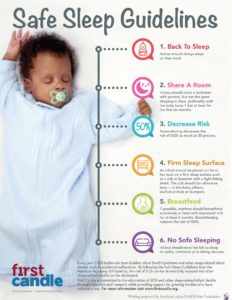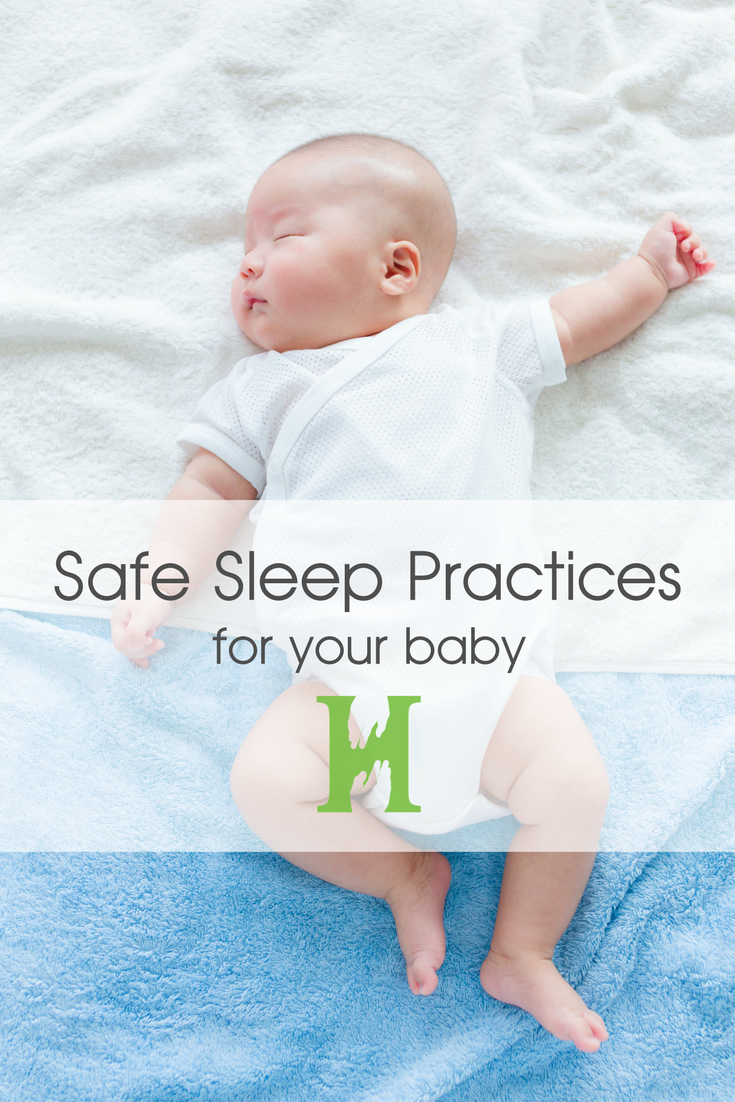by Hand to Hold staff, in collaboration with SafeKids Austin & Travis County Medical Examiner
There are few pleasures that can compare with holding your sleeping baby in your arms. Any parent who has spent time in the NICU can tell you exactly what it meant to them to hold their baby for the first time! Once we bring our fragile babies home we do everything we can to keep them close and protect them. This includes being well-informed about safe sleep practices.
Reduce the Risk
According to First Candle, “Despite the existence of compelling research and statistics about the importance of safe sleep in reducing our nation’s high rate of infant mortality, the number of babies who die in adult beds and other unsafe sleep environments is on the rise. In fact, of the more than 4,500 sudden, unexpected infant deaths each year, statistics show that as many as 80-90 percent are the result of unsafe sleep practices. These are preventable deaths.” Unsafe sleeping environments might include an adult sleeping with a baby on an overstuffed couch, placing an infant in a crib with a bumper and with pillows and toys, or sleeping with them in an adult bed with comforters and pillows. Read the AAP’s sleep safety recommendations on First Candle.
The ABCs of Safe Sleep
Your baby should sleep
- Alone
- on its Back
- in a Crib
- with the Dangers Eliminated
Your baby’s sleeping area should include:
- no pillows
- no blankets
- no bumper pads
- no toys
- no clutter
- no cords
- no smoking
Giving your baby a safe place to sleep could save their life. In 2015, more than 900 babies under the age of one died due to not having a safe place to sleep.
So why such strict requirements?
Safe Sleep Checklist
-
Always place babies to sleep on their backs. Side and tummy positions are not safe unless recommended by a physician.
- Put your baby to sleep in an empty safety-approved crib, bassinet, or pack-and-play. The mattress should be firm and fit snuggly in the crib. Cover the mattress with only a tight-fitting crib sheet.
- Babies should have their own sleep space, near a parent or caregiver’s bed in order to keep them safe and make breastfeeding easier. This is called room sharing. Bed sharing is not safe for babies.
- Falling asleep with a baby in bed, or on a couch, arm chair, or futon is dangerous.
- Do not put anything soft, loose, or fluffy in a baby’s sleep area. This includes pillows, blankets, comforters, crib bumpers, toys, or other soft items.
- Educate everyone who cares for your baby on how to put your baby safely to sleep.
Share a Room, Not a Bed
Caring for an infant, especially an infant who has recently returned home from the hospital, can be an exhausting time for parents under the best circumstances. Some preemies may come home with special equipment, such as apnea monitors, oxygen or feeding tubes, which makes having their own space very important.
When possible place the baby’s crib or bassinet near your bed or in the same room, so you can reach your child to breastfeed, bond and care for your infant. When its time for sleep, place baby back in their bed.
Clear Baby’s Sleeping Area
Of course you want your baby to be comfortable and cozy, but toys and blankets can be a hazard. Your baby’s sleeping area should meet the following requirements:
- The sleeping area should be free of toys, stuffed animals, blankets and pillows. They could be at risk of becoming wrapped up in sheets and blankets.
- Make sure cords of all types, from infant monitors to mini-blinds, are out of reach.
- Avoid placing your your baby to sleep on any soft surface such as bean bag chairs, recliners, soft couches and quilts or heavy blankets.
- Remove the crib bumper from your baby’s crib to remove the danger of becoming wedged next to it. Despite their small size, tiny infants can sometimes move around in surprising ways. Use only a snug mattress with a tight-fitting sheet, and ensure that your crib complies with the latex safety regulations.
Wearable blankets, such as Halo’s SleepSack® or Woombie, are some examples of alternatives to keeping babies snug without risking entanglement. You may also swaddle your baby. Experts recommend keeping the room at a comfortable room temperature to keep baby from overheating.
Alternative, Safe Decorations for Baby’s Room
It is now possible to find crib sets without the crib bumper. And manufacturers are offering fashionable crib skirts and dust ruffles, which are out of reach as baby snoozes. see Consumer Report’s Crib Bedding Buying Guide
Supervise Tummy Time
When baby is awake, be sure you make tummy time a priority, and watch them at all times. This exercise gives them time to develop strong neck and shoulder muscles they will need to keep their head up. This is the perfect time to let them play with toys and stuffed animals. Read “Back to Sleep. Tummy to Play” for more tips.
Tell All Your Caregivers How to Keep Baby Safe While Sleeping
Following safe sleep guidelines reduces your baby’s risk of dying of SIDS, falling, becoming trapped, or accidentally suffocating. While it’s tempting to rationalize sleeping with your baby, the facts are that there are inherent risks with co-sleeping. Even if you sleep lightly, don’t use sleep aids, don’t smoke or use medications, you may still put your baby at unnecessary risk. And, be sure to let grandparents, babysitters and others who care for your baby how to keep your baby safe while they sleep. Remember: Room Sharing is Always Safer than Bed Sharing!
Download this Child Caregiver Safe Sleep Checklist from First Candle.
Resources:
Updated 2016 Recommendations for a Safe Infant Sleeping Environment from the American Academy of Pediatrics
Back to Sleep. Tummy to Play from the American Academy of Pediatrics
Safe to Sleep® – Crib Information Center from the U.S. Consumer Product Safety Commission
Reduce the Risk of SIDS from HealthyChildren.org
Safer Sleeping from ConsumerReports.org
Safe and Sound Babies from the TEAM for West Virginia Children
SIDS Data & Statistics from the Centers for Disease Control



